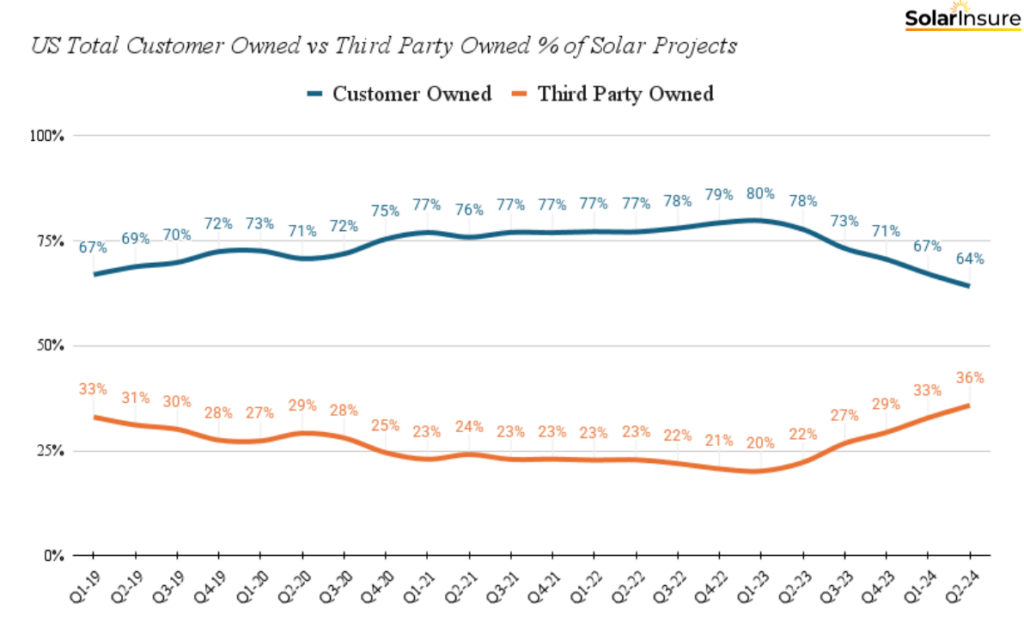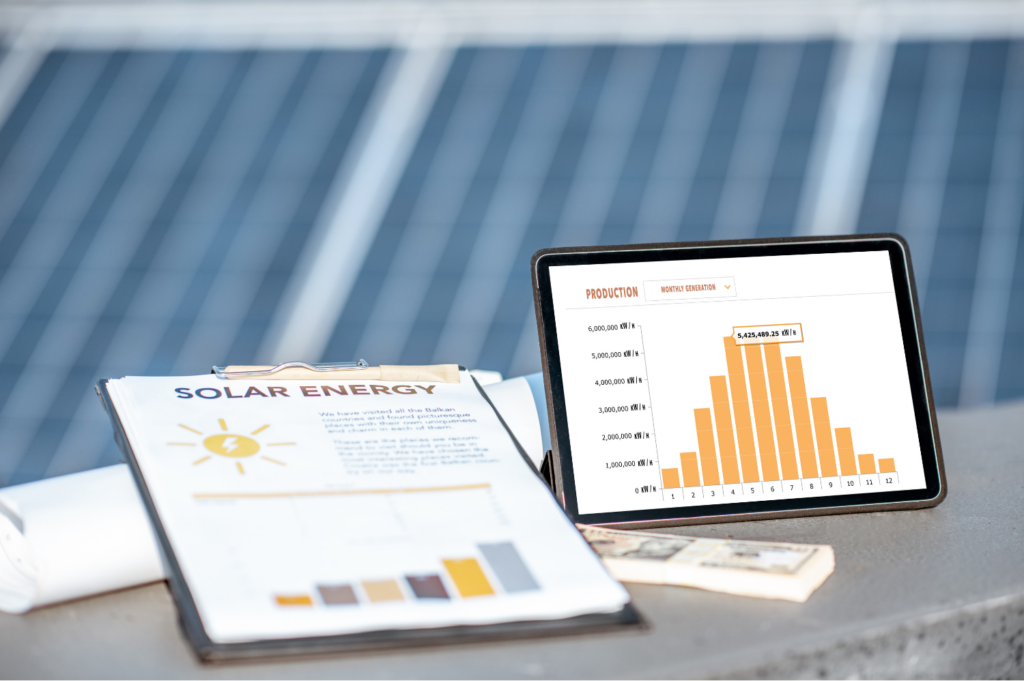For many years the solar industry has been split between two options for signing up homeowners; third-party ownership (TPO – lease and PPA) and customer-owned systems (cash & loan). Over the years, the two methods have varied in total percentage of market ownership with customer-owned making up the majority.
Recent data from Ohm Analytics suggests the split is closer than it has been since early 2019. So why is that? Both options have pros and cons, and the overall market can determine the leader.
Table of Contents
Overview of the Data

The data in the above graph comes from an Ohm Analytics report on residential projects installed in the US from Q1 2019 to Q2 2024.
Throughout the history covered in this data set, the blue line shows that customer-owned systems have had a clear advantage over TPO systems, holding two-thirds to three-quarters of the market at times. The rationale behind this makes a lot of sense, generally, those looking to install solar have wanted it as a cost-saving investment for their home. Owning their equipment is the only way to utilize solar as an investment, so that has been the natural first step.
The difference peaked in Q1 or 2023, where customer-owned systems However, in early 2019 and now in mid-2024, we see TPO starting to close the gap. Before diving in too deep on why that is, it’s important to know how the two differ, as well as the pros and cons of each option.
Customer-Owned
Customer-owned systems are those in which the homeowner purchased the solar equipment from a solar installation company and paid for it with either cash or by taking a loan.
When someone owns their solar array, they fully benefit from the energy savings and tax benefits associated with it. Unlike TPO cases where homeowners receive a bill from their solar provider, customer-owned systems get to enjoy 100% of the savings benefit.
As a simple example: let’s say a home requires $10 of energy per day and they install a solar energy system to cover 100% of that energy need. If the homeowners own their solar, they save $10. If that homeowner signed up with a TPO that advertised “save 20% on your electric bills”, the solar would feed $10 of energy into their home but the TPO provider would bill them for $8. There’s still a saving, but the amount is far greater when the system is customer-owned.
As for tax benefits and incentives, homeowners who own their solar arrays get federal and local area incentives (if available) to offset their costs.
Additionally, customer-owned systems get the benefit of increased home values. In a previous study, Solar Insure looked at 5,000 single-family homes sold in California between 2020-2023. Homes with customer-owned solar arrays sold for 5-10% more than similar homes without solar. Homes with leased (TPO) solar energy systems didn’t sell for more than homes without solar.
Solar providers who adopt more customer-owned systems also report having more control over the post-sale relationship, healthier cash flow, higher close rates, and lower cancellation rates. Selling customer-owned deals requires more in-depth training and knowledge building with homeowners, which generally leads to greater customer satisfaction.
However, there are some pitfalls with customer-owned systems too. Owning the system means the homeowner needs to have access to extra cash or be able to qualify for a loan. In recent years, loans have also come at higher interest rates, causing some to look toward TPO. Owning your solar energy system can also come with maintenance costs down the road – though those can be mitigated by adding independent warranties like SI-30 Solar and SI-30 Total from Solar Insure.
Customer-Owned Pros
- Significantly higher energy savings
- Federal & local incentives to offset costs
- Increase in home value
- Healthier business operations and cash flow
Customer-Owned Cons
- Ability to have cash available or qualify for a loan
- Ability to benefit from tax incentives
- Long-term maintenance liability
Third-Party Ownership
TPO Solar looks at how much a homeowner is paying for energy monthly or annually and sets a price below that to save the customer some money. In exchange, the TPO provider installs and maintains the panels are no cost to the homeowner. The TPO provider also receives any of the tax benefits and local incentives to help pay down their investment. Those, coupled with recurring monthly payments from the homeowner provide a return on investment for the company.
Homeowners who invest in TPO solar don’t benefit from energy savings as much or receive any additional value to their homes when they sell. Moving can also be tricky, as some have reported selling a home with a solar lease presents a significant obstacle.
For solar providers, working with a TPO provider can cause some stress. Many providers report too heavily investing their business in TPO results in significant money tied up in the TPO provider, meaning they completed installation but haven’t been paid by the lease company. Without money coming in, sales reps are often owed commissions but unable to collect on them, leading to frustration.
From a competitive standpoint, selling TPO removes value from a sales pitch. Rather than being able to relay your company’s expertise and history of successful projects, sales reps are forced to sell entirely on trying to hit a rock bottom price with slim margins for the company.
TPO Pros
- Simplified value proposition
- Limited long-term liability
TPO Cons
- Limited energy savings
- Limited benefit to home value, complicates home selling
- Potential for poor cash flows
- Stuck selling on price rather than value
How the Market Affects the Products Sold

Solar is a fluctuating space with incentives, grid policies, and consumer sentiment on a continuous roller coaster.
Looking at the data set, market variances can help explain some of the numbers. 2019 was originally supposed to be the last year of the full federal ITC, starting in 2020 it would decrease to 26%. You see throughout 2019 the amount of customer-owned systems increased, and then COVID hit.
Due in part to the COVID pandemic, interest rates sat at historic lows. Being so cheap to borrow money, customer-owned solar saw continued increases, peaking in Q1 of 2023 when the market was 80% customer-owned and 20% TPO. As we’ve all now experienced, inflation and rising interest rates began in early 2023. Because money became so much more expensive to borrow, we see a pretty significant jump in the amount of TPO hitting the market.
What Will Lead The Market Going Forward?
As the data has shown, no single product will ever completely dominate the industry because there are different use cases and values drawing homeowners to both.
Customers who have access to cash or financing may still lean toward customer-owned options as a better investment and for the return on investment.
Someone without tax liability or access to funds will likely lean toward TPO because it still provides value in a manageable way for them.
I see the data eventually swinging back toward what we saw in 2020-2023, where customer-owned represented three-quarters of the market. As interest rates lower, potential new local incentives pop up, and grid instability becomes more of a factor, customer-owned models will dominate because of their prowess as an investment.
The real shift happening in solar isn’t just about financing models—it’s about how providers build long-term value. Contractors who focus solely on TPO may find themselves chasing volume over profitability, while those embracing customer-owned systems are creating more sustainable, service-driven businesses. The data shows that as interest rates stabilize and consumer education improves, customer-owned models will dominate again. The most successful providers aren’t just selling a system—they’re delivering trust, longevity, and financial security to their customers.
Dean Chiaravallotti – CRO, Solar Insure



